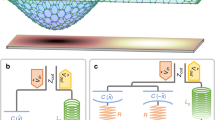Summary
The usefulness of electromodulation as a probe of critical-point symmetry is limited by the variation in the optical response that an electric field ℰ can produce. Modulation of allowed interband transitions causes changes in reflectivity polarization of at most 2 to 3. Rather than measuring this easily masked, common symmetry signature, we propose concentrating on electronic states which have low optical-transition probability in the absence of a field. When ℰ directionally breaksk-conservation, it can then cause extremely large symmetry-sensitive changes in optical properties. This is demonstrated for extrinsic states in indirect-gap semiconductors; ≈1015 cm−3 centers per 1 meV of energy width can be uniquely and self-consistently characterized by electromodulation. We make numerous suggestions for intrinsic-state electromodulation studies that should be extremely symmetry sensitive.
Riassunto
L’utilità dell’elettromodulazione come mezzo per l’analisi della simmetria dei punti critici è limitata dalla variazione nella risposta ottica che un campo ℰ può produrre. La modulazione delle transizioni interbanda permesse causa cambiamenti della polarizzazione della riflettività al massimo di un fattore 2÷3. Invece di misurare questo comune e facilmente mascherato segno di simmetria, si propone di concentrarsi su quegli stati elettronici che hanno bassa probabilità di transizione ottica in assenza di campo. Quando il campo ℰ rompe la conservazione dik lungo una direzione, può indurre cambiamenti estremamente grandi in quelle proprietà ottiche che sono sensibili alla simmetria. Questo è dimostrato per gli stati estrinseci in semiconduttori a gap indiretto; si è in grado di determinare univocamente ed in modo autoconsistente ≈1015 cm−3 centri per un intervallo di energia di 1 meV. Si danno numerosi suggerimenti per studi di elettromodulazione degli stati intrinseci che dovrebbero essere estremamente sensibili alla simmetria.
Резюме
Применимость электромодуляции для исследования симметрии критической точки ограничена изменением оптического отклика, который может образовать электрическое поле ℰ. Модуляция разрешенных междузонных переходов вызывает изменения в поляризации в лучшем случае от 2 до 3 раз. Мы предлагаем исследовать электронные состояния, которые имеют малую вероятность оптического перехода в отсутствии поля. Когда ℰ нарушает сохранениеk, это может служить причиной чрезвычайно большого изменения чувствительности к симметрии в оптических свойствах. Это обстоятельство демонстрируется для примесных состояний в полупроводниках с непрямой щелью. Мы высказываем ряд предложений для исследования собственных состояний с помощью метода электромодуляции, который является очень чувствительным к симметрии.
Similar content being viewed by others
Footnotes
B. O. Seraphin andR. B. Hess:Phys. Rev. Lett.,14, 138 (1965);J. C. Phillips:Phys. Rev.,146, 584 (1966);N. Bottka andV. Roessler:Sol. State Comm.,5, 939 (1967).
B. O. Seraphin: inSemiconductors and Semimetals, edited byR. S. Willardson andA. C. Beer, Vol.9 (New York, N. Y., 1972), p. 136.
D. S. Kyser andV. Rehn:Bull. Amer. Phys. Soc.,17, 238 (1972);V. Rehn:Surf. Sci.,37, 443 (1973).
N. Bottka andJ. E. Fischer:Phys. Rev. B,3, 2514 (1971).
D. E. Aspnes:Phys. Rev. Lett.,28, 913 (1972).
R. S. Bauer:Journ. Elec. Mat.,4, 1067 (1975).
B. O. Seraphin:Optical Properties of Solids, Proceedings of the V International Conference, Chania, Greece, edited byE. D. Haidemenakis (New York, N. Y., 1969), p. 213.
R. S. Bauer:Optical Properties of Solids. New Developments, edited byB. O. Seraphin (Amsterdam, 1976), p. 339.
D. E. Aspnes andJ. E. Fischer:Comm. Sol. State Phys.,4, 159 (1972).
R. S. Bauer andR. D. Burnham:Phys. Rev. Lett.,34, 1088 1540 (E) (1975).
D. E. Aspnes:Suf. Sci.,37, 418 (1973).
R. S. Bauer: Lecture 27L3,Proceedings of the Autumn School on Modulation Spectroscopy, Sunny Beach, Bulgaria, 1976 (to be published).
A. Frova andP. Handler:Phys. Rev. Lett.,14, 178 (1965).
D. E. Aspnes andN. Bottka: inSemiconductors and Semimetals, edited byR. S. Willardson andA. C. Beer, Vol.9 (New York, N. Y., 1972), p. 457.
R. S. Bauer, D. R. Scifres andR. D. Burnham:Physics of Semiconductors: Proceedings of the XIII International Conference (Roma, 1976), p. 1286.
V. S. Vinogradov:Sov. Phys. Solid State,13, 2745 (1972).
J. E. Fischer:Surf. Sci.,37, 473 (1973), conference discussion, and cited references, especiallyE. W. Williams:Sol. State Comm.,7, 541 (1969).
R. Enderlein: personal communication.
J. L. Deiss andA. Daunois:Surf. Sci.,37, 804 (1973).
J. L. Shay andJ. H. Wernick:Ternary Chalcopyrite Semiconductors: Growth, Electronic Properties, and Applications (Oxford, 1975).
Author information
Authors and Affiliations
Additional information
Traduzione a cura della Redazione.
Переведено редакцией.
Rights and permissions
About this article
Cite this article
Bauer, R.S. Electromodulation symmetry sensitivity. Nuov Cim B 39, 378–386 (1977). https://doi.org/10.1007/BF02725762
Received:
Published:
Issue Date:
DOI: https://doi.org/10.1007/BF02725762




